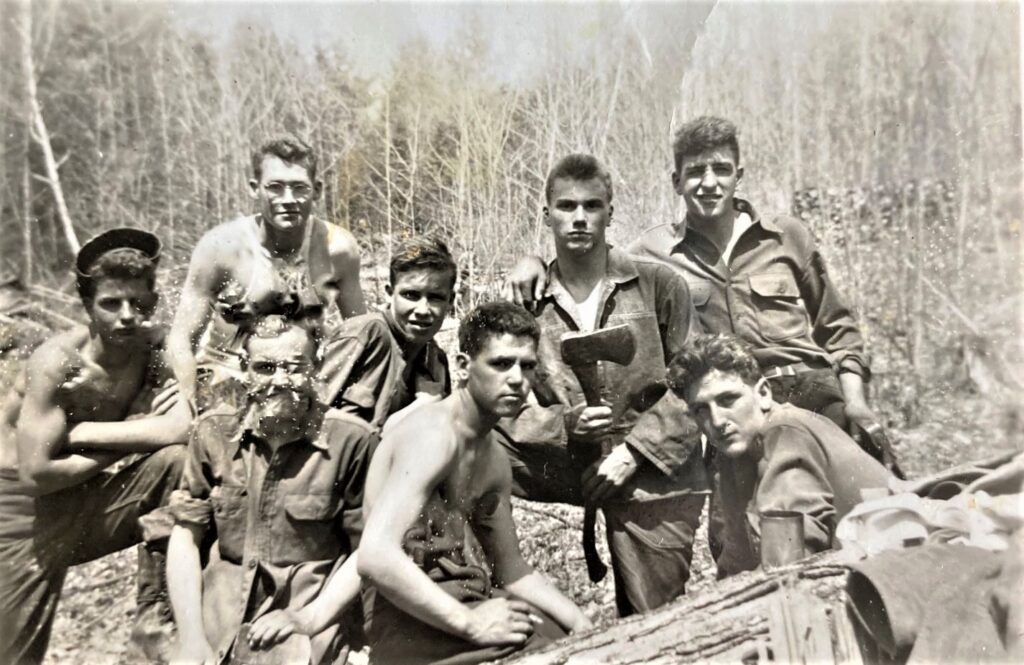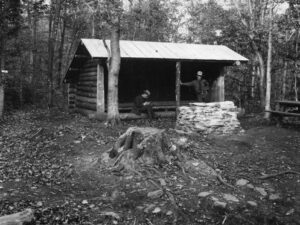A version of this article appears in the Spring 2024 Long Trail News and contains much of the same information from the 2024 Taylor Series presentation titled “The History of the Vermont Civilian Conservation Corps Camps.” Both the article and presentation are by Martin Podskoch.
How many times have you hiked on the Long Trail, hoping with every step you’d come across a shelter or lean-to that you could rest your weary bones, have a bite to eat, and perhaps a place to sleep for the night? Today, there are 72 backcountry shelters on the Long Trail System, built over decades by volunteers, Long Trail Patrol crews, and the CCC. But what was the CCC?
The Civilian Conservation Corps (CCC) was a public works program that operated from 1933 to 1942 as part of President Franklin D. Roosevelt’s New Deal. It targeted single men, 18-25 years old, and WWI veterans who had difficulty finding jobs during the Great Depression. The program provided unskilled manual labor to support environmental conservation projects and the development of natural resources in rural lands.
Roosevelt proposed the Emergency Conservation Work (ECW) Act, commonly known as the Civilian Conservation Corps, which laid out a plan to recruit thousands of unemployed young men, enroll them in a peacetime army, and send them into “battle” against destruction and erosion of our natural resources. Roosevelt said, “I propose to create a Civilian Conservation Corps to be used in simple work … more important, however, than the material gains will be the moral and spiritual value of such work.”
The proposal went to Congress March 21, 1933, and Roosevelt signed the executive order on April 5, now considered the birthday of the CCC. Roosevelt promised to enroll 250,000 young men by July of that same year. On April 7, the first enrollee was selected and by April 17, the first camp was in operation in the Shenandoah Valley, near Luray, Virginia—Camp Roosevelt.
The federal Department of Labor, through its state and local relief offices, was responsible for the selection and enrollment of applicants. Enrollees had to be single and unemployed men aged 18-25 who received Home Relief, an early government benefits program. They enrolled for six-month stints and worked a 40-hour week for $30 per month. Food, housing, uniforms, and medical care were provided. The government sent $25 per month home to the workers’ parents and gave the men $5 spending money. By July 1, 1933, there were 275,000 enrollees and 10,000 supervisory personnel in 1468 camps. It was the fastest large-scale mobilization of men in United States history.

The United States Army supervised each camp, which consisted of approximately 200 men each. There were camps in all 48 states and the four territories at the time. Many camps were segregated by race, and integrated companies with both White and Black enrollees were often assigned to remote locations. There were also separate camps for Native Americans, and WWI veterans.
The CCC helped to shape the modern national and state park systems we enjoy today, with work in more than 800 parks nationwide.
 The CCC in Vermont
The CCC in Vermont
Vermont was slated to host four CCC camps, but the passionate lobbying of legendary State Forester Perry Merrill raised that number to more than 30, from Bellows Falls to St. Albans.
Workers built trails, roads, campsites, and dams; stocked fish; built and maintained lookout towers, lookout cabins, and telephone lines; fought fires; and planted millions of trees. In Vermont, the CCC laid the foundation for much of the state parks system. To a lesser extent, they played a role in the Long Trail system’s development.
Peru Camp

The Peru camp worked on the southern part of the Long Trail. The young men built and maintained shelters, girdled trees, and removed slash from the trail. They also built the beautiful Hapgood Pond recreation area and a trail from the park to the Long Trail.

In 1935 the CCC built the original Griffith Shelter with space for 10. It was renamed Peru Peak Shelter in 1966, following the construction of the nearby Griffith Lake Shelter. In 1979 the Youth Conservation Corps and U.S. Forest Service rebuilt the shelter, as it stands today. They built the Mad Tom Notch Shelter, since replaced in 1962 and then by Bromley Shelter in 2003.
The Peru Camp built the Stratton Mountain fire tower 1934, which is enjoyed by Long Trail, Appalachian Trail, and day hikers to this day.
In addition, the Peru camp planted thousands of trees. In 1983, the Forest Service cut logs from that stand of trees that were then used to construct the Spruce Peak Shelter on the Long Trail. The four-walled enclosed shelter has bunks for 16.

Other Notable CCC work on the Long Trail
After the flood of 1936 the Rochester CCC camp did maintenance work on the Long Trail. The Company 133 Weston/East Wallingford camp built shelters on the Long Trail in Wallingford Pond area. The Underhill Camp constructed the CCC Road going up the back side of Mount Mansfield that led to the Long Trail. The CCC road is now considered a side trail used by day hikers to access the Laura Cowles Trail, Sunset Ridge Trail, and eventually Mount Mansfield’s ridgeline.
The CCC’s Legacy
The CCC disbanded in 1942 due to increased employment opportunities, changes in public opinion, lack of funding, and the need for soldiers to serve in World War II.
The CCC program is considered one of the most successful of Roosevelt’s New Deal programs. Roosevelt’s “Tree Army” planted more than three billion trees on land made barren from fires, natural erosion, intensive agriculture, or logging. In fact, the CCC was responsible for over half the reforestation, public and private, in the nation’s history.
The CCC helped to shape the modern national and state park systems we enjoy today. CCC’s efforts were instrumental in creating 94 national parks and 741 state parks, enjoyed by millions of people each year, including young children, teens, and older adults. In Vermont, we see their work on and off the Long Trail, in state parks, and in critical infrastructure like the Little River Dam, East Barre Dam, and more.
The CCC also laid the groundwork for important partnerships between the Green Mountain Club, US Forest Service, and Department of Labor. Today, GMC works with youth corps modeled after the CCC, including AmeriCorps National Civilian Conservation Corps and the Vermont Youth Conservation Corps. The support of members and donors like you enable GMC to employ these crews on large-scale projects like the Burrows Trail reconstruction, continuing Roosevelt’s legacy of public-private work corps that create employment opportunities for youth and contribute to the preservation of public lands and recreation opportunities.
About the Author
Martin “Marty” Podskoch is the author of three CCC books covering the Adirondacks, Connecticut, and Rhode Island, and is now writing a book on the Vermont CCC camps. If anyone has photos or information on CCC work in VT, please contact him. Books and more info available at www.martinpodskoch.com.
Watch Marty’s 2024 Taylor Series presentation, “The History of the Vermont Civilian Conservation Corps Camps.”




















Leave a Reply